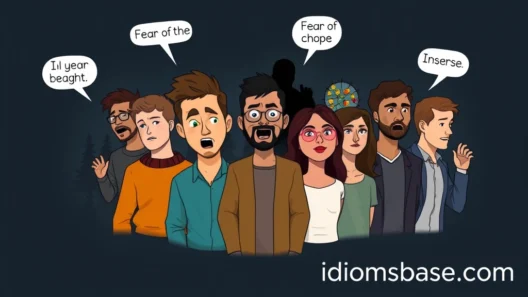Ever found yourself in a moment where words just… vanished? Where the air was so still, you could almost taste the quiet? Silence isn't just the absence of sound; it's a powerful presence, a canvas for emotions, and a storyteller in its own right. It can be deafening, comforting, or even terrifying. But how do we describe something so profound yet intangible? That's where metaphors come in!
Metaphors are like magic wands for language, transforming the ordinary into the extraordinary. They help us paint vivid pictures with words, giving abstract concepts a tangible form. And when it comes to silence, there's a whole symphony of ways to describe its many faces. Ready to dive into a world where quiet speaks volumes? Let's explore 38 captivating metaphors for silence that will enrich your vocabulary and deepen your understanding of this often-overlooked phenomenon.
The Echoes of Absence: 38 Metaphors for Silence
Silence, in its various forms, can be a heavy cloak, a vast ocean, or even a watchful guardian. Here are some incredible ways to describe it:
- A Blanket of Snow: Imagine fresh snow, muffling all sound. This metaphor perfectly captures a soft, pervasive quiet that absorbs noise.
- A Deep Well: Silence here is profound and seemingly bottomless, suggesting a vast, introspective quiet.
- A Heavy Curtain: This implies a deliberate, almost oppressive quiet, perhaps in a room where an important decision is being made.
- A Vaulted Chamber: Think of a grand, empty space where sound would simply dissipate, leaving an imposing stillness.
- A Canvas Unpainted: Here, silence is potential, waiting for sound or words to fill it, suggesting anticipation or emptiness.
- A Still Pond: Reflecting everything without a ripple, this metaphor evokes a serene, undisturbed peace.
- A Sealed Tomb: This is a much darker take, suggesting a final, absolute, and perhaps chilling silence.
- A Whispering Ghost: Paradoxically, this implies a presence in the quiet, a lingering emptiness that hints at past sounds.
- A Frozen Lake: Hard, unyielding, and reflecting stillness, this can suggest a cold, rigid silence.
- A Deserted Highway: Emphasizes emptiness and absence, where normally there would be constant activity.
- A Locked Door: Symbolizes a barrier, a refusal to speak or engage, keeping sounds and words out.
- A Muffled Drum: Suggests a sound that's been suppressed or dulled, hinting at a quiet that's not entirely complete.
- A Waiting Room: Implies anticipation and a temporary pause, a quiet before something begins.
- A Swallowed Voice: This powerful metaphor speaks of words that are held back, unsaid, and perhaps painful.
- A Void: The most absolute of all, suggesting a complete absence of anything, including sound.
- A Padded Room: Evokes a sense of complete sound absorption, often associated with isolation or mental health.
- A Breath Held: A tense, expectant quiet, where everyone is waiting for something to happen.
- A Closed Book: Represents a finished story, a conversation ended, or a secret kept.
- A Shadow: Elusive and often unnoticed until pointed out, a quiet that blends into the background.
- A Glass Wall: Suggests a barrier that separates, allowing sight but preventing sound or communication.
- A Stone Wall: Implies an impenetrable, unyielding quiet, difficult to break through.
- A Black Hole: A powerful metaphor for a silence that consumes everything, leaving nothing.
- A Ghost Town: Evokes an eerie quiet, where signs of past life are present but no current activity.
- A Silent Scream: A profound paradox, highlighting an internal turmoil that cannot be expressed outwardly.
- A Caged Bird: Suggests a voice that is trapped and unable to sing, a forced quiet.
- A Stolen Voice: Implies a loss, a voice that was taken away, leading to an unwilling silence.
- A Broken Record: A silence that follows a sudden stop, a jarring halt to sound.
- A Nod of Agreement: A non-verbal communication that bypasses words, signifying understanding in quiet.
- A Shrug of Indifference: Expresses a lack of concern or engagement, often accompanied by silence.
- A Deep Sigh: More than just a sound, it can be a release of emotion that speaks volumes without words.
- A Closed Mouth: The most direct, indicating a refusal or inability to speak.
- An Empty Nest: A poignant silence, representing absence and the quiet that follows departure.
- A Mute Witness: Suggests a silence that observes without comment, often implying powerlessness or complicity.
- A Still Frame: Captures a moment frozen in time, devoid of the continuous flow of sound.
- A Fading Echo: The last remnants of sound dying away, leaving an expanding quiet.
- A Silent Promise: A commitment made without words, relying on trust and understanding.
- A Guarded Secret: A silence that protects information, often heavy with unspoken knowledge.
- A Pause for Thought: A deliberate, often brief, quiet chosen for reflection or consideration.
Why Do We Use Metaphors for Silence?
You might be wondering, why go to all this trouble to describe something that's just… nothing? Well, silence is rarely 'nothing.' It's often filled with meaning, emotion, or tension. Using metaphors allows us to:

- Convey Emotion: Is the silence peaceful, awkward, or menacing? A "blanket of snow" feels very different from a "sealed tomb."
- Add Depth: Metaphors make our descriptions richer and more nuanced. Instead of just "it was quiet," we can say "the silence was a heavy curtain."
- Engage the Reader: Vivid imagery captures attention and helps readers connect with the text on a deeper level.
- Show, Don't Tell: Instead of telling someone the silence was oppressive, you can show it by calling it a "vaulted chamber."
Key Takeaways
- Silence is more than just the absence of sound; it's a powerful concept with many facets.
- Metaphors are essential tools for describing abstract ideas like silence in vivid, relatable ways.
- The choice of metaphor for silence can dramatically alter the emotion and meaning conveyed.
- From "a blanket of snow" to "a black hole," each metaphor paints a unique picture of quiet.
Frequently Asked Questions

Q1: What is the primary purpose of using metaphors for silence?
A1: The primary purpose is to give tangible form and emotional depth to an abstract concept. Silence isn't always just the absence of sound; it can be filled with meaning, tension, or peace. Metaphors help convey these nuances and make descriptions more vivid and engaging.
Q2: Can metaphors for silence be used in everyday conversation?
A2: Absolutely! While some metaphors might be more poetic, many can be seamlessly integrated into daily speech to add color and precision. For example, saying "the room went silent as a tomb" is a common way to describe a sudden, profound quiet.
Q3: How do metaphors differ from similes when describing silence?
A3: Metaphors directly state that silence is something ("Silence is a heavy curtain"), implying a direct equivalence. Similes, on the other hand, compare silence to something using "like" or "as" ("Silence was like a blanket of snow"). Both are figures of speech that enhance description, but metaphors offer a stronger, more direct identification.
Q4: Are there cultural differences in how silence is perceived or described?
A4: Yes, definitely! In some cultures, silence can signify respect or contemplation, while in others, it might indicate discomfort or disagreement. These cultural perceptions often influence the metaphors used to describe silence, with some cultures having richer lexicons for specific types of quiet.
Q5: How can I choose the best metaphor for a specific situation involving silence?
A5: Consider the emotion, context, and atmosphere you want to convey. Is the silence peaceful (a still pond)? Tense (a breath held)? Eerie (a ghost town)? Or oppressive (a sealed tomb)? The best metaphor will resonate with the specific feeling or message you're trying to communicate.
We hope this journey through the quiet corners of language has inspired you! Which metaphor for silence resonates most with you? Do you have a favorite that wasn't on our list? Share your thoughts and let the conversation begin! After all, even in the silence, there's always something to discover.







